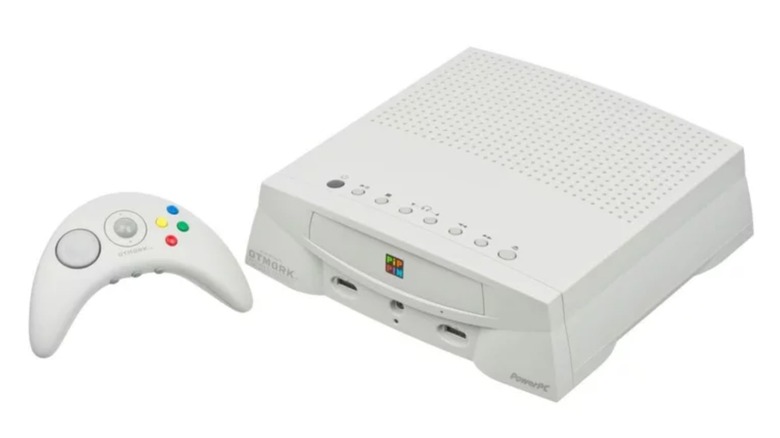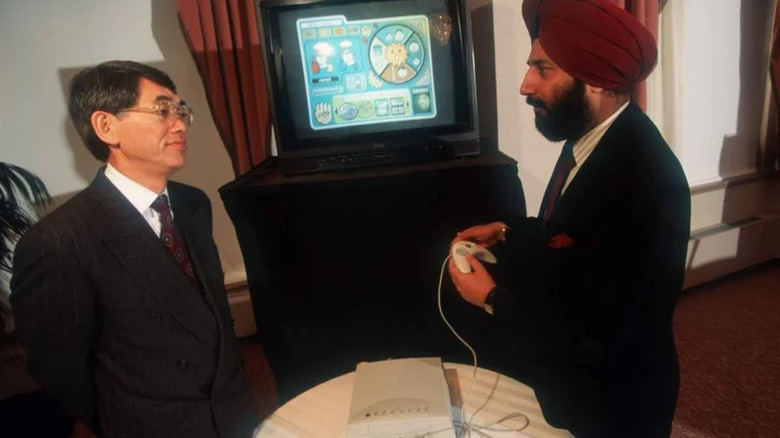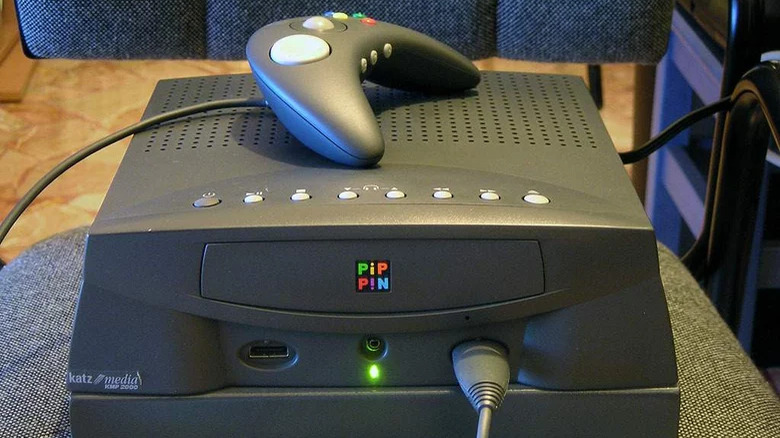The Apple Game System That Failed Early In The Console Wars
Apple is not a name you usually associate with the infamous console wars of the early '90s. But way before the era of the iPods and the iPhones, in the age of the PlayStation 1, the Nintendo 64, and the Sega Saturn, Apple tried its hand at developing its own gaming console. The result was the Apple Pippin, a product that would eventually go down in history as one of the worst Apple products ever made, possibly even superseding the likes of the infamous Hockey Puck mouse and the Newton tablet.
Today, even though it is mostly known among computer and gaming nerds for being a terrible gaming console (via Museum of Failure), Apple's original vision for the Pippin was much bigger. The company envisioned the product as a versatile multimedia device that was a far more capable, all-round device compared to the standalone consoles of the time. In hindsight, this decision ended up making a "neither here, nor there" product that tried to do everything but ended up doing a lousy job at every single one of them.
Here's a brief history of the Apple Pippin — the company's first (and only) gaming console, how it came to being, and what led to its catastrophic failure.
Why did Apple develop the Pippin?
The mid-90s was a happening era for both the gaming and computing space. The home computer and the gaming console industry were both in their early days. Gaming consoles of the time were relatively affordable devices that slotted comfortably under the $300 mark. On the other hand, personal computers were a lot more expensive, and the high cost prevented people from adopting them en masse.
Apple, which had been working with Japanese toymaker and (then) gaming console company Bandai, worked out plans for a gaming console (via AppleScoop) that would essentially be a scaled-down version of the Apple Macintosh of the time. The idea was to create a product that could not only play games but would attract a larger audience that longed for a PC-like device. In addition, this device could also act as a communications platform, handle interactive music, and even don the hat of an educational tool, all while also retaining the capability to play games.
This invariably meant Apple could demand a higher price tag for it compared to 'mere' gaming consoles and also position it as a viable personal computer replacement that did not cost an arm and a leg. While the idea sounded great on paper, the execution was less than spectacular. Soon after its introduction in 1996, bad reviews and poor reception meant Apple pulled it off the market barely a year after it was introduced. The Pippin lived longer in the Japanese market, where Bandai continued supporting it until 2002.
What made the Pippin special?
The Pippin was a unique product by any stretch of the imagination. It was essentially a scaled-down version of an Apple Mac product of the time — Apple Performa 5200. Those aware of Apple history should know that the Performa 5200 – in hindsight – was largely considered among the worst Apple computers of all time — mainly because it performed poorly compared to its similarly priced competition.
Given that Performa 5200 was already infamous for its poor performance, it was no surprise that the Apple Pippin was no spirited performer. The Pippin ran a modified version of Mac OS 7 (also called System 7), and this lent it some unique capabilities — unheard of on gaming consoles at the time.
It offered support for modem connectivity and could connect peripherals like keyboards and mice. It was also the only gaming console at the time to offer slots for adding additional DRAM modules. The Pippin even came with PCI-like expansion slots that could be used for adding external peripherals. Users could simply connect the Pippin to their existing televisions to start using the device.
Why did it fail?
Even though Apple was involved with the development of the Pippin, it was not fully committed to the project and primarily envisioned it as an open platform for which others could develop customized products. Japanese toymaker Bandai showed keen interest in the project and was responsible for making the hardware in its home country, where it came in white color and was sold under the Atmark branding.
The key reason for the Pippin not taking off, however, was its prohibitive price tag of $650 in Japan. When the product eventually made it to the U.S., where it was called the Bandai Pippin @ World (via BonAirInsider Archive), Apple wanted users to pay $600 for the product. This made it more than three times as expensive as popular gaming consoles of the time – including the $299 PlayStation and the Nintendo 64.
Apple's marketing teams could not convince anyone about Pippin's supposedly superior capabilities that went beyond the realms of gaming. And it did not help Pippin's cause when the product was advertised as a gaming console. Even though Apple banked on the broader availability of CD-ROM titles for the Pippin, there was a dearth of quality games for the Pippin, further driving away potential gamers. All these factors eventually meant that Apple and Bandai together only managed to sell around 42,000 units of the Pippin worldwide (via TechRadar). Apple as a company was also under a lot of turmoil at the time, and was even on the verge of bankruptcy at one point.
What accelerated the demise of Pippin, however, was the return of Steve Jobs to Apple in 1997. Steve, who was unceremoniously sacked from Apple in 1985, came back to the company that year and would go on to make several sweeping decisions, one of which included the scrapping of the Pippin. In hindsight, Steve's comeback was crucial for Apple and he would go on to lay the foundation of the modern Apple Inc. we know today.



